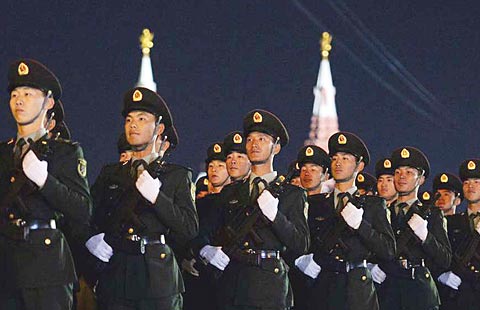
China's Silk Road projects to help turn countries into economic standouts once again
The residents of Khiva in Uzbekistan might be forgiven for thinking the Silk Road trading caravans of old had come to stop at the mud-walled heart of their ancient trading city.
The city, between the Karakum and Kyzylkum deserts, has had its ups and downs since it was founded in the 6th century AD.

|
Top: A mosque in Tashkent, Uzbekistan, and above, an Uzbek woman makes a carpet. Photos provided to China Daily |
But a new idea that has come from the East seems likely to boost the fortunes of Khiva, as well as Central Asian countries like Uzbekistan and Kazakhstan and even more distant countries such as Belarus in Eastern Europe and beyond.
The plan, which has come to be called One Belt, One Road, refers to the Silk Road Economic Belt and the 21st Century Maritime Silk Road, based on trade and infrastructure projects, and proposed by President Xi Jinping in late 2013.
The Silk Road Economic Belt alone links East Asia and Europe and covers more than 40 countries in an area inhabited by 3 billion people.
The initiative is energizing all levels of society that live along this modern Silk Road, from the young to the old.
"All my classmates hold positive attitudes toward One Belt, One Road, because as the projects go on, there will be more Chinese companies coming to Uzbekistan, which is good news for us," says Babup Polotov, a native of Khiva who is a graduate student of Tashkent State Institute of Oriental Studies studying Chinese language.
Many details remain to be worked out, and some have expressed concern about protecting local businesses, but a lot of sentiment focuses on the immense potential for economic and societal progress that the initiative represents.
Central Asian countries play a key role. An expert at the Center for Economic Research, a think tank based in Tashkent, the Uzbek capital, says the initiative would bring significant benefits to Uzbekistan. As part of the southern route of the new Silk Road, Uzbekistan would profit from cooperation among China, Iran and Turkey. The northern route through Russia and Kazakhstan would boost the economic development of the whole region.
Victor Abaturov, the head of analytics for Economic Review magazine, published by the Center for Economic Research, says the One Belt, One Road Initiative includes economic collaboration as well as cultural exchanges, helping to create a stronger political relationship.
"Uzbekistan and China have established partnerships, and the two countries have already had some multi-angle plans," Abaturov says.

Sino-Uzbek trade has risen in recent years, setting the stage for One Belt, One Road. Sino-Uzbek trade volume in 2014 reached $4.27 billion, compared with $2.17 billion in 2011. Energy and agriculture are highlights.
"We have similar views on some regional issues, and we pay great attention to cultural exchanges," Abaturov says. "We also set up a Day of China and a Day of Uzbekistan. So we can see that One Belt, One Road is a complex project, rather than a simple economic cooperation plan."
Infrastructure adjustments will be needed to get the most from the plan. One of the main barriers for railways is the difference in gauges. "We have to redesign tracks and locomotives to fix the Uzbek standard if this cooperation is to be accomplished," says Wu Hongwei, a researcher at the Institute of Russian, Eastern European and Central Asian Studies, part of the Chinese Academy of Social Sciences.
Kazakhstan is another country hoping to benefit from One Belt, One Road. Its GDP per capita is among the top three countries out of the Commonwealth of Independent States. The country announced it would participate in the Silk Road Economic Belt project in January last year, a few months after Xi made the proposal.
Nurlan Yermekbayev, the nation's ambassador to China, has told China Daily that the historical Silk Road was also a complex cultural and economic bridge between East and West that united people.
The ambassador says China's customs data shows that a huge increase in bilateral trade also has set the stage for greater cooperation. Trade has increased almost 300 fold, from $104 million in 1992 to $28.5 billion last year.
Kazakhstan has become China's largest trade partner in Central Asia, and second after Russia among countries in Eastern Europe and the Commonwealth of Independent States. China is Kazakhstan's largest foreign trade partner, contributing more than 20 percent of Kazakhstan's foreign trade.
The two countries' presidents have set a target to bring trade up to $40 billion in a few years, Yermekbayev says. The relationship is sure to grow as Chinese investment projects create jobs for Kazakh workers, he says.
Political stability is a big advantage in attracting partners to the new Silk Road, given that foreign investors prefer sustained policies and a stable market, says Zhumatay Salimov, deputy chairman of Kazakhstan's National Agency for Technological Development.
One Belt, One Road meshes well with the goals of Kazakhstan, which wants more bilateral and multilateral cooperation, Salimov says. The country also hopes to become a member of the World Trade Organization.
China is a major partner with Kazakhstan in the energy business, and the country is now trying to promote and support innovation programs and high-tech industries and is looking for opportunities for further cooperation, says Rassul Kizatov, managing director of Kaznex Invest.
"We hope that the new Silk Road will bring us further cooperation with China in non-resources sectors, such as manufacturing," Kizatov says.
Kazakhstan is also looking for more educational exchanges. Some 1,000 Chinese students are studying at Kazakhstan's universities and institutes, according to the Kazakh Education Ministry.
Kazakhstan has been giving an especially warm welcome to Chinese students and tourists since the leaders of the two countries signed an agreement in 2013 to make 2017 the year of tourism from China to Kazakhstan.
Belarus, while in Eastern Europe, is typical of nations that want to use their location to reap rewards from the new Silk Road. "The ancient Silk Road connected China with Europe, and we believe that this time our country will play its due role in the new one," says Prime Minister Mikhail Myasnikovich.
The Eastern European leader said in an exclusive interview with China Daily that Belarus, "at the crossroads of an important trade route linking the Baltic Sea to the Black Sea, and Russia to the European Union", has a very special location on the route. "There is a positive perception of the proposal in the country."
Belarus wants to push for related projects and to build a transport corridor, he says.
China's exports to Belarus reached $1.62 billion in the first seven months of 2013, a year-on-year increase of 46.7 percent, according to China's Ministry of Commerce. Exports from Belarus to China in the same period stood at $363 million, an increase of only 5.6 percent.
Myasnikovich says Belarus plans to build a logistics distribution center with help from China. He also says his country has purchased 12 high-powered locomotives from China and plans to import 18 more under an agreement signed in July. The two countries will cooperate on railway electrification, he adds.
Myasnikovich says the bilateral cooperation has entered a new phase. Chinese high-tech companies such as ZTE and Huawei have expressed their willingness to join the China-Belarus Industrial Park, he says. The park, near Minsk International Airport, will grant tax exemptions to enterprises for the first 10 years and 50 percent tax breaks for another 10 years.
While the One Belt, One Road project is hailed by local authorities and investors, disagreements have arisen among some low-end local industries and small companies. While many agree that China's increased presence would strengthen the competitiveness of domestic industries, some worry that if Chinese companies and products pour in, some local enterprises may go bankrupt.
But Abaturov says that as One Belt, One Road processes, the governments will sign agreements about further economic interaction and try to introduce Chinese companies to local industries. The Uzbek government needs to guarantee its own interests and make sure agreements benefit Uzbek enterprises, he says.
The importance of One Belt, One Road should not be underplayed, says Richard Giragossian, director of a think tank based in Yerevan, Armenia.
The plan has two implications, Giragossian says. "The first is (that) those peoples, those countries failing to see the strategic opportunity from the Silk Road will be left behind."
"The second ... is that when we look at the strategic trajectory of the new Silk Road, it's also much less about the old concept of pipelines. The most important pipelines in terms of this new Silk Road will not only be those carrying gas and oil, but fiber optic pipelines."
renqi@chinadaily.com.cn
(China Daily Africa Weekly 05/08/2015 page8)







